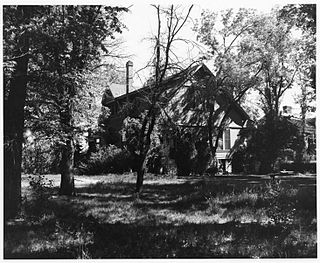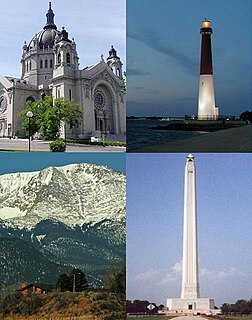
The Sanseer Mill is a historic 19th-century mill at 282 Main Street Extension in Middletown, Connecticut. It was added to the United States National Register of Historic Places in 1986.

Riverside Hotel is a former hotel and casino located in Downtown Reno, Nevada, that sits on the exact location where Reno began in 1859. The building now houses apartments and studios for artists and is listed on the National Register of Historic Places.

The Francis G. Newlands Home is a historic house at 7 Elm Court in Reno, Nevada, United States. Built in 1890, it is the former mansion of United States Senator Francis G. Newlands (1846-1917), a driving force in passage of the 1902 Newlands Reclamation Act. It was declared a National Historic Landmark in 1963 and listed on the National Register of Historic Places in 1966. The house is privately owned and is not open to the public.

The U.S. National Register of Historic Places (NRHP) classifies its listings by various types of properties. Listed properties generally fall into one of five categories, though there are special considerations for other types of properties which do not fit into these five broad categories or fit into more specialized subcategories. The five general categories for NRHP properties are: building, district, object, site, and structure.

Grand Canyon Village Historic District comprises the historic center of Grand Canyon Village, on the South Rim of the Grand Canyon in Grand Canyon National Park, Arizona. The district includes numerous landmark park structures, many of which are National Historic Landmarks themselves, or are listed on the National Register of Historic Places. The town design as a whole is also significant for its attention to integration with the Grand Canyon landscape, its incorporation of National Park Service Rustic design elements, and for the idiosyncratic design of park concessioner structures such as the El Tovar Hotel.

The Twaddle Mansion was built for rancher Ebenezer "Eben" Twaddle in Reno, Nevada. The two-story frame house was built in 1905 by contractor Benjamin Leon in the Colonial Revival style, an unusual choice for Nevada, and executed with particular opulence.

The Twaddle-Pedroli Ranch, also known as the Jackson-Harp Ranch, Rand Property and the Wilson Commons Ranch, was purchased by John Twaddle in 1869 for $5,000. The ranch, several miles to the north of Franktown, Nevada and adjacent to the Bowers Mansion, was then known as the Sturtevant Ranch. The property amounted to 630 acres (250 ha).

There are eight properties listed on the National Register of Historic Places (NRHP) in Linn County, Kansas.
In the United States, the National Register of Historic Places classifies its listings by various types of architecture. Listed properties often are given one or more of 40 standard architectural style classifications that appear in the National Register Information System (NRIS) database. Other properties are given a custom architectural description with "vernacular" or other qualifiers, and others have no style classification. Many National Register-listed properties do not fit into the several categories listed here, or they fit into more specialized subcategories.

The George Tromley Sr. House is a historic building located in Le Claire, Iowa, United States. It has been listed on the National Register of Historic Places since 1979. The property is part of the Houses of Mississippi River Men Thematic Resource, which covers the homes of men from LeClaire who worked on the Mississippi River as riverboat captains, pilots, builders, and owners. It is also a contributing property in the Cody Road Historic District.

The John R. Twelves House is a historic house located in Provo, Utah, United States. It is listed on the National Register of Historic Places.

The John Gregovich House, at 101 Summit in Tonopah, Nevada, United States, is a historic house built in 1906 that is listed on the National Register of Historic Places. Like the Zeb Kendall House, also built in Tonopah in 1906 and also NRHP-listed, it is of Neo-Colonial style.

The Washoe County Courthouse, at 117 S. Virginia St. in Reno, Nevada, was built in 1910. It is significant for playing a role in the divorce industry in Nevada during the first half of the 20th century, when divorce was legal in Nevada and liberal residency requirements were enacted, while divorce was much more difficult elsewhere. In 1931, more than 4,800 divorces were processed in northern Nevada, most processed through this courthouse; it was economically important, with $5,000,000 being spent per year in Reno by divorcing parties.
George A. Ferris & Son was an architectural firm in Reno, Nevada, consisting of partners George Ashmead Ferris (1859-1948) and his son Lehman "Monk" Ferris (1893-1996). The partnership lasted from just 1928 to 1932; both father and son however were individually prominent.

The David Smaill House, at 313 W. Ann St. in Carson City, Nevada, was built in c.1876. Also known as the Smaill House, it was listed on the National Register of Historic Places in 1985.

The Downtown Reno Library is the main library of the Washoe County Library System, at 301 S. Center St. in Reno, Nevada. It occupies a historic Modern-style building listed on the National Register of Historic Places as the Washoe County Library. It is known also as the Downtown Library. It was designed by Hewitt Campau Wells in Modern style and was built in 1965.
















